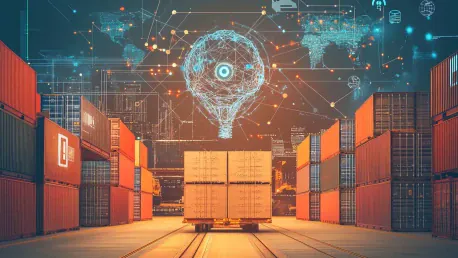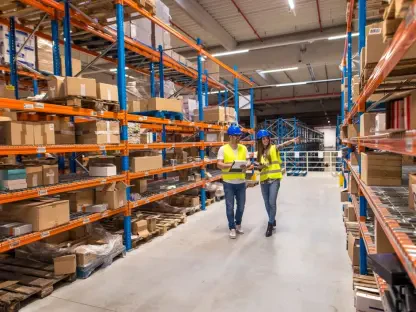The dynamic landscape of the global supply chain is being shaped by technological advancements, consumer demands, and geopolitical factors. Industries must continually adapt to these evolving challenges, with key themes such as AI adoption, the importance of robust cybersecurity measures, and the escalating demand for rapid e-commerce shipping becoming increasingly prominent. As the world continues to globalize, logistics and manufacturing sectors are leveraging these trends to enhance their resilience and efficiency.
The Resilience of Globalization
Globalization remains a cornerstone of the global economy despite ongoing geopolitical tensions. International trade has proven its mettle through numerous tests, including significant events such as Brexit, the U.S.-China trade war, and the COVID-19 pandemic. These events have undeniably posed challenges, but they haven’t dismantled the apparatus of globalization.
The resilience of globalization is evident in the participation of countries not aligned with major geopolitical powers, like India, Vietnam, Brazil, and the UAE, which are expanding their roles in global trade. These nations act as economic bridges between geopolitical rivals such as the U.S. and China, underscoring globalization’s enduring strength. Their involvement in the global trade landscape provides stability and continuity, mitigating the impacts of geopolitical rivalries and fostering broader economic collaboration.
Furthermore, the endurance of globalization can be linked to the increasing mobility of goods across longer distances. Contrary to the notion of a shift towards regionalization, traded goods now travel longer distances than ever before. This trend indicates a robust demand for international collaboration, further solidifying globalization as an integral facet of the global economy.
The Demand for Faster Shipping in E-commerce
The e-commerce sector is witnessing a significant transformation driven by rising consumer expectations for faster delivery. With industry giants like Amazon setting high benchmarks for rapid shipping, smaller retailers are being compelled to keep pace by offering expedited shipping options. The competitive pressures have led to a considerable rise in merchants providing faster shipping alternatives.
There has been a marked increase in the availability of two-day and next-day shipping options among retailers. For example, the number of merchants offering two-day shipping has surged by approximately 47% in recent years. The most dramatic shift is seen in same-day shipping services, which have increased by an impressive 164%. This trend reflects the growing consumer willingness to pay more for quicker delivery, especially for essential and high-demand items like health and wellness products, electronics, and apparel.
While meeting these consumer demands presents several challenges, including increased operational costs reported by about 84% of merchants, it also brings opportunities for differentiation. Retailers that can strategically plan and innovate their logistics operations stand to gain a competitive edge. Implementing advanced technological solutions and optimizing supply chain processes allow retailers to not only meet but exceed customer expectations, potentially fostering greater brand loyalty and market share.
Mixed Sentiments Within the Supply Chain Sector
Within the supply chain sector, executive sentiment is split between optimism and pessimism, reflecting the complex landscape businesses must navigate. The Trade in Transition research program highlights this blend of optimism about leveraging new technologies and growth opportunities, balanced by concerns over economic uncertainties and operational disruptions.
On the positive side, supply chain executives see immense potential in emerging technologies to streamline operations, enhance efficiency, and drive innovation. The adoption of AI, automation, and advanced data analytics offers promising avenues to mitigate risks and address supply chain vulnerabilities. These technologies are viewed as key drivers for improving transparency, predictive capabilities, and resilience across the supply chain.
Conversely, economic uncertainties and operational disruptions pose significant challenges. Supply chain executives express trepidation over geopolitical instability, fluctuating trade policies, and potential market downturns. Additionally, logistics and manufacturing sectors continue to grapple with issues such as labor shortages, rising costs, and transportation bottlenecks. These concerns contribute to a cautious approach to investment and decision-making within the industry.
The Potential of AI for Small Manufacturers
AI has long been associated with large corporations, but its transformative potential extends to small and mid-sized manufacturers (SMMs) as well. AI can assist SMMs in improving supply chain resilience by leveraging operational and product data. This capability allows even smaller players to mitigate disruptions more effectively and enhance their agility amidst changing market conditions.
The application of AI in manufacturing encompasses various technologies, including advanced sensing, blockchain, and machine learning tools. These technologies can help SMMs optimize production processes, enhance quality control, and streamline logistics. For instance, AI-driven predictive maintenance can reduce downtime and improve equipment efficiency, while machine learning models can better anticipate demand fluctuations and adjust operations accordingly.
However, the adoption of AI faces significant challenges, particularly concerning data privacy and secure data sharing. To address these issues, fostering public-private partnerships and leveraging federal AI initiatives are critical. Ensuring that smaller manufacturers have access to the necessary resources and support channels will be pivotal in overcoming these hurdles and realizing AI’s full potential in enhancing supply chain resilience.
Emerging Cybersecurity Threats
As the trucking industry undergoes rapid digitization, cybersecurity has emerged as a crucial concern. The path toward modernization is fraught with risks such as advanced phishing attacks, AI-driven cyber threats, and vulnerabilities associated with the Internet of Things (IoT). The 2025 Trucking Cybersecurity Trends Report sheds light on these key risks and underscores the need for robust cybersecurity measures within the industry.
AI-enhanced phishing schemes, for example, have become more sophisticated, posing higher risks of data breaches and financial losses. These schemes often exploit advanced machine learning algorithms to deceive even the most cautious employees. Consequently, adopting more advanced email security measures and conducting comprehensive employee training have become vital strategies to counteract these threats.
The trucking industry is also addressing the growing concern of cyber-enabled cargo theft and IoT vulnerabilities in trucks and warehouses. Implementing a Zero-Trust Architecture is essential to prevent unauthorized access and safeguard sensitive data. The IoT infrastructure requires robust security protocols to ensure that interconnected devices do not become entry points for cybercriminals.
The National Motor Freight Traffic Association (NMFTA) emphasizes the need for immediate investment in stronger detection tools, proactive risk mitigation strategies, and thorough employee training. By prioritizing these cybersecurity measures, the trucking industry can better protect its digital ecosystem and maintain operational integrity.
Barriers to AI Adoption
Despite the recognized importance of AI in transforming supply chains, its widescale adoption continues to face several obstacles. Key impediments include trust issues, skills gaps within the workforce, challenges related to data governance, and budget constraints. These barriers hinder many organizations from fully embracing AI and reaping its potential benefits.
A significant hurdle is the lack of trust in AI among both senior management and employees. Concerns about the reliability and transparency of AI-driven solutions lead to hesitation in their adoption. Trust deficits are often fueled by insufficient understanding of AI technologies and fear of unintended consequences. To address this, fostering a culture of knowledge-sharing and providing comprehensive AI education and training within organizations can build confidence in its capabilities.
Additionally, skills gaps pose a significant challenge, as the successful implementation of AI requires advanced technical expertise. Investing in workforce development and training programs can bridge these gaps, ensuring that employees are equipped with the necessary skills to effectively leverage AI tools. Prebuilt AI solutions tailored to industry-specific needs can also mitigate concerns and facilitate smoother adoption.
Moreover, data governance challenges and budget limitations constrain AI initiatives. Ensuring robust data privacy measures and secure data sharing protocols can alleviate privacy concerns, while strategic allocation of resources can help overcome financial constraints. Through collaborative efforts and strategic investment, organizations can navigate these barriers and unlock the transformative potential of AI in their supply chains.
The Push for Digital Transformation
The global supply chain is undergoing a transformation driven by technological innovations, shifting consumer expectations, and geopolitical factors. To navigate these changes, industries must stay adaptable. Key factors include the integration of AI, which is revolutionizing how supply chains operate by optimizing processes and predicting trends. Additionally, the need for robust cybersecurity measures is more critical than ever, as protecting sensitive data from cyber threats is essential in maintaining trust and operational integrity.
The rise of e-commerce has also led to a significant demand for faster shipping solutions, prompting logistics and manufacturing sectors to reconsider and refine their strategies. Rapid delivery is no longer a luxury but a necessity to meet consumer demands and stay competitive in a globalized market.
By embracing these trends, businesses can not only enhance their resilience against disruptions but also improve efficiency and customer satisfaction. As the world continues to globalize, it is crucial for enterprises to harness technological advancements and strengthen cybersecurity to secure their place in the future market. The dynamic nature of the supply chain will continue to present challenges, but those who adapt will thrive, turning potential obstacles into opportunities for growth and innovation.









